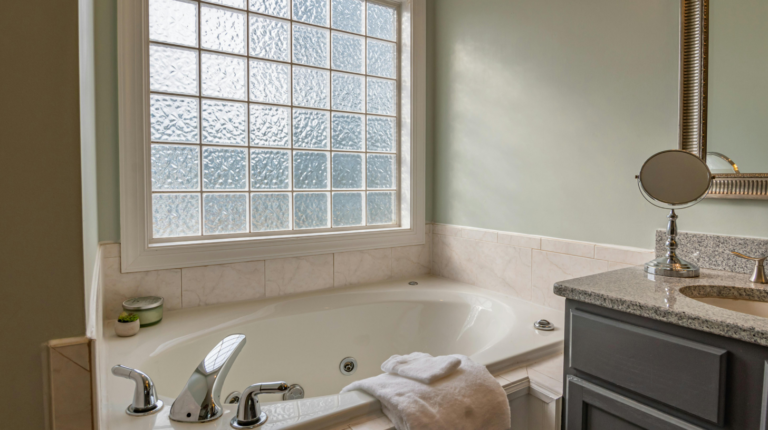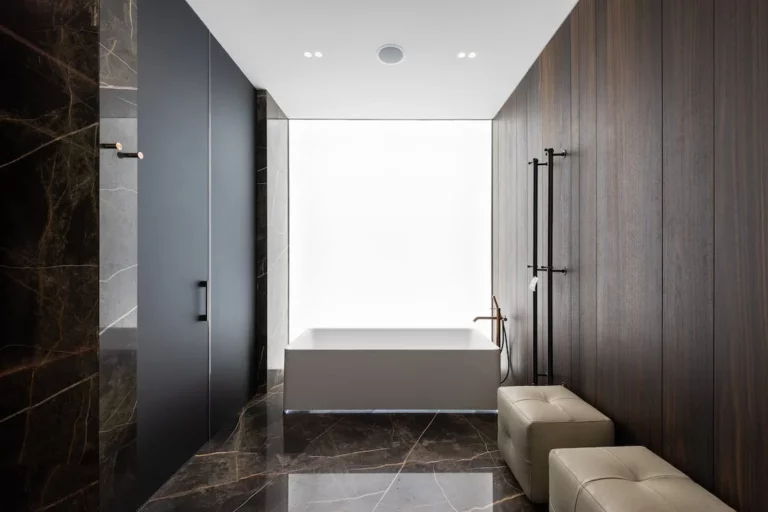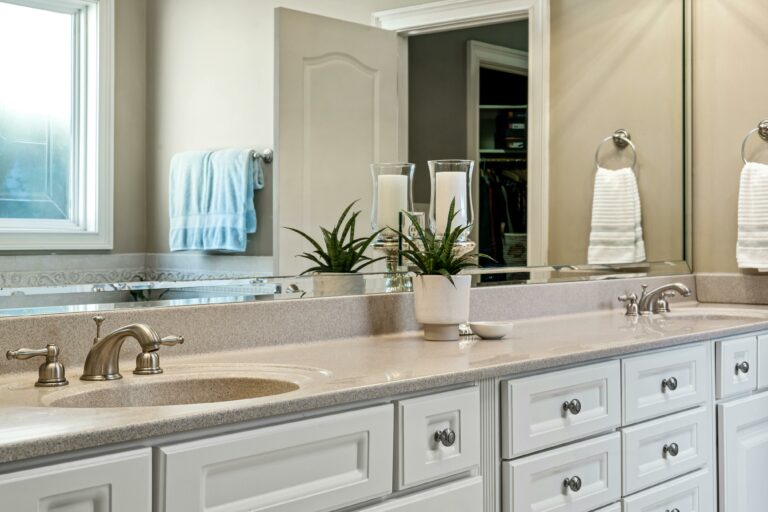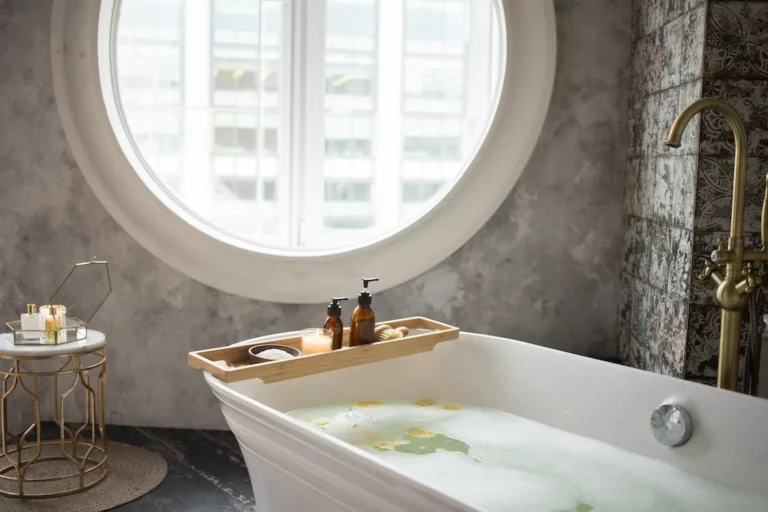The Art of Choosing Bathroom Tiles: Tips for Homeowners in 2023
Hey there! Are you in the process of renovating your bathroom? One of the most important decisions you’ll make is choosing the right tiles. Bathroom tiles not only enhance the aesthetics of your space but also play a crucial role in its functionality and durability. With so many options available, it can be a bit overwhelming to figure out where to start. But fret not! In this article, we’ll guide you through the art of choosing bathroom tiles to help you create the perfect retreat in your home.
Whether you’re going for a modern and sleek look or a rustic and cozy vibe, selecting the right tiles can make a significant difference in your bathroom’s overall design. We’ll dive into the various types of bathroom tiles, considerations to keep in mind when making your selection, tips for choosing the right tile size and shape, exploring different colors and patterns, tile layout and installation techniques, grout options, and finishing touches. By the end of this article, you’ll feel confident in making an informed decision that suits your style, budget, and practical needs.
So, let’s get started on this exciting journey of transforming your bathroom into a beautiful and functional space that you’ll enjoy for years to come!
Table of Contents
- 1 The Art of Choosing Bathroom Tiles
- 2 Considerations for Choosing Bathroom Tiles
- 3 Choosing the Right Tile Size and Shape
- 4 Exploring Different Tile Colors and Patterns
- 5 Tile Layout and Installation Techniques
- 6 Grout Options and Finishing Touches
- 7 Working with a Professional or DIY?
- 8 Conclusion
- 9 Frequently Asked Questions
The Art of Choosing Bathroom Tiles
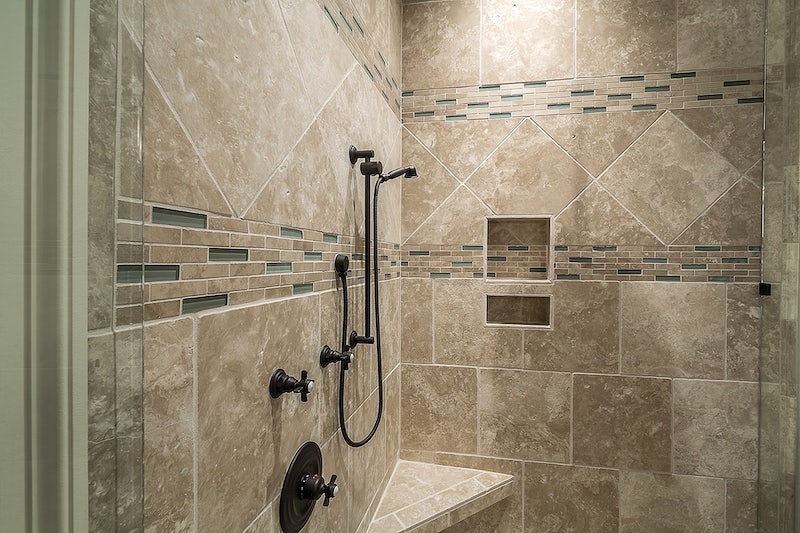
When it comes to choosing tiles for your bathroom, the options can seem overwhelming. With so many sizes, shapes, colors, and materials available, it’s essential to understand the different types of bathroom tiles before making a decision. In this section, we will explore some popular options to help you make an informed choice.
Ceramic Tiles
Ceramic tiles are a common and affordable option for bathroom flooring and walls. They are made from clay and other natural materials, which are then kiln-fired to create a durable and water-resistant tile. Some benefits of ceramic tiles include:
- Affordability: Ceramic tiles are more budget-friendly compared to other options, making them a popular choice for homeowners.
- Variety: They come in a wide range of colors, patterns, and textures, allowing you to achieve various looks for your bathroom.
- Easy Maintenance: Ceramic tiles are easy to clean and maintain. Regular sweeping and mopping will keep them looking their best.
Porcelain Tiles
Porcelain tiles are a type of ceramic tile that undergoes a higher temperature firing process. This results in a denser and more durable tile that is resistant to moisture and stains. Here are some reasons why porcelain tiles are a popular choice:
- Durability: Porcelain tiles are highly durable and suitable for high-traffic areas like bathrooms. They can withstand heavy foot traffic without wearing down.
- Water Resistance: The low water absorption rate of porcelain tiles makes them ideal for bathrooms, where moisture is a common concern.
- Versatility: Porcelain tiles come in a variety of styles, including ones that mimic the look of natural stone or wood.
Glass Tiles
Glass tiles can add a touch of elegance and sophistication to your bathroom. They are available in various shapes, colors, and finishes, allowing you to create unique and eye-catching designs. Consider the following benefits of glass tiles:
- Reflective Properties: Glass tiles have a reflective quality that can make your bathroom appear larger and brighter.
- Easy to Clean: Because of their smooth and non-porous surface, glass tiles are easy to wipe clean, making them a great choice for shower walls and backsplashes.
- Color Options: Glass tiles come in a wide range of color options, allowing you to create stunning designs and accents in your bathroom.
Stone Tiles
Stone tiles, such as marble, granite, or travertine, can bring a natural and luxurious feel to your bathroom. Here are some reasons why stone tiles are a popular choice for homeowners:
- Elegance and Timelessness: Stone tiles offer a timeless beauty that can enhance the overall aesthetic of your bathroom.
- Durability: Stone tiles are incredibly durable and can withstand heavy use. They can last for many years with proper care and maintenance.
- Unique Patterns and Textures: Each piece of stone is unique, which means your bathroom will have a one-of-a-kind look with stone tiles.
Mosaic Tiles
Mosaic tiles are small tiles, usually measuring less than 2 inches, that are arranged in intricate patterns or designs. They can be made from various materials such as ceramic, glass, or natural stone. Here’s why you might consider mosaic tiles for your bathroom:
- Visual Appeal: Mosaic tiles are a great way to add visual interest, texture, and depth to your bathroom. They can create stunning statement areas or accent features.
- Flexibility: Mosaic tiles can be easily customized and used in different areas of your bathroom, such as shower walls, backsplashes, or even as decorative borders.
- Easy to Install: Despite their intricate appearance, mosaic tiles are often mounted on mesh sheets, making them easier to install compared to individually laying small tiles.
With a better understanding of the different bathroom tile options available, you can narrow down your choices based on your budget, desired aesthetics, and functional needs. Remember to consider factors such as durability, maintenance requirements, and overall style when making your decision.
Considerations for Choosing Bathroom Tiles

When it comes to choosing bathroom tiles, there are several important factors to consider. The right tiles can enhance the overall look and functionality of your bathroom, so it’s essential to make an informed decision. Here are some key considerations to keep in mind before making your tile selection:
Budget and Cost
- Determine your budget for the tile project. Tiles come in a wide range of materials and price points, so it’s important to have a clear idea of how much you’re willing to spend.
- Remember to factor in installation costs and any additional materials you may need, such as adhesive or grout.
Durability and Longevity
- Consider the durability of the tiles, especially in high-moisture areas like bathrooms. Look for tiles that are water-resistant, scratch-resistant, and able to withstand heavy foot traffic.
- Porcelain and ceramic tiles are popular choices for bathrooms due to their strength and durability. They are resistant to stains, moisture, and bacteria, making them an excellent option for a long-lasting bathroom.
Maintenance and Cleaning
- Think about the time and effort you’re willing to invest in maintaining your bathroom tiles. Some tiles may require regular sealing or special cleaning products to keep them looking their best.
- Porcelain and ceramic tiles are relatively low-maintenance and easy to clean. They are resistant to stains and can be cleaned with regular household cleaners.
Style and Aesthetics
- Consider the overall style and design of your bathroom. Choose tiles that complement the existing fixtures and decor.
- Whether you prefer a modern, minimalist look or a more traditional style, there are tiles available in various colors, patterns, and finishes to suit your taste.
Safety and Slip-Resistance
- Slippery bathroom floors can be hazardous, especially for young children or anyone with mobility issues. Look for tiles with a slip-resistant surface or a high coefficient of friction to increase safety.
- Avoid using highly-polished tiles in areas where water may accumulate, such as shower floors. Instead, opt for textured tiles that provide better traction.
Remember that choosing bathroom tiles is a long-term investment, so it’s important to carefully consider your options. Don’t hesitate to seek professional advice or consult with a tile supplier for expert guidance. With the right tiles, your bathroom can become a beautiful and functional space that you’ll enjoy for years to come.
“Your choice of bathroom tiles can greatly influence the overall look and feel of your space. Consider your budget, durability, maintenance requirements, style preferences, and safety concerns when making your selection. Remember, it’s a long-term investment that deserves careful consideration.”
Choosing the Right Tile Size and Shape

When it comes to choosing the right tiles for your bathroom, size and shape play a crucial role in determining the overall look and feel of the space. From large format tiles to geometric shapes, there is a wide range of options available. Here are some tips to help you make the right choice:
Large Format Tiles
- Large format tiles, typically measuring 12×24 inches or larger, can create a sense of spaciousness and elegance in your bathroom.
- They are especially popular for modern and minimalist designs, as they minimize grout lines and create a seamless look.
- Keep in mind that larger tiles may require more precise installation to ensure they lay flat and avoid any lippage.
Small Format Tiles
- Small format tiles, such as mosaic tiles or subway tiles, can add texture and visual interest to your bathroom.
- These tiles are versatile and can be arranged in various patterns and designs.
- They are an excellent choice if you want to create a vintage or traditional look in your bathroom.
Rectangular Tiles
- Rectangular tiles, like subway tiles or plank tiles, are a popular choice for bathroom walls and floors.
- They visually elongate the space and create a sense of continuity.
- You can choose a vertical or horizontal installation depending on the effect you want to achieve.
Square Tiles
- Square tiles, such as 12×12 or 18×18 tiles, are a classic choice for bathroom floors and walls.
- They offer a timeless look and work well with both contemporary and traditional styles.
- Square tiles can be laid in various patterns, including straight, diagonal, or herringbone, to add visual interest.
Geometric Shapes
- If you want to add a modern and unique touch to your bathroom, consider using tiles with geometric shapes.
- Hexagonal, diamond, or arabesque tiles can create stunning focal points and enhance the overall design.
- Just remember to carefully plan the layout and ensure a precise installation to achieve the desired look.
Remember, the size and shape of the tiles you choose can significantly impact the visual appeal of your bathroom. Whether you go for large format tiles to create a sleek look or opt for mosaic tiles to add texture, there is a perfect option for every style and preference. Take some time to explore different sizes and shapes, and don’t be afraid to mix and match for a truly personalized design.
Exploring Different Tile Colors and Patterns

When it comes to choosing bathroom tiles, one of the most exciting parts is exploring the endless possibilities of colors and patterns. The color and pattern you choose can have a significant impact on the overall look and feel of your bathroom. Whether you prefer a minimalist and serene space or a bold and vibrant design, there are plenty of options to suit your personal style. Let’s dive into the world of tile colors and patterns!
Neutral and Subtle Tones
Neutral colors are a timeless choice for bathroom tiles that can create a calm and soothing atmosphere. Shades of white, beige, gray, and cream are popular options that can easily blend with any decor. These neutral tones provide a clean and elegant backdrop, allowing you to experiment with other design elements in your bathroom easily. Additionally, they give the illusion of a larger and brighter space, making them perfect for smaller bathrooms.
Bold and Vibrant Colors
If you’re looking to make a statement and add a pop of personality to your bathroom, bold and vibrant colored tiles are the way to go. Consider using tiles in shades of blue, green, red, or even yellow to create a lively and energetic atmosphere. These colors can instantly uplift the mood of your space and give it a unique flair. Just be mindful of the overall color scheme of your bathroom and ensure that the colors complement each other harmoniously.
Patterned Tiles
Patterned tiles are a fantastic choice for adding visual interest and depth to your bathroom. From geometric designs to intricate motifs, patterned tiles can transform a plain space into a work of art. You can opt for a full wall or floor covered in a bold pattern, or use patterned tiles as accents to create a focal point. Just remember to balance the patterns with the rest of your bathroom elements, such as fixtures and accessories, to avoid overwhelming the space.
Monochromatic Designs
If you prefer a more cohesive and harmonious look, monochromatic tile designs are a great option. These designs feature different shades and textures of a single color, creating a subtle yet sophisticated look. For example, using various shades of gray tiles can add depth and dimension to your bathroom without being too flashy. Monochromatic designs are also versatile and can easily be paired with other colors or patterns for a more eclectic touch.
Accent Tiles
To add a touch of personality and create visual interest, incorporating accent tiles into your bathroom design is a fantastic idea. Accent tiles are usually used sparingly, often as a border or in a specific area like the shower niche or backsplash. They can feature unique patterns, bold colors, or even metallic finishes to stand out from the rest of the tiles. Accent tiles can be the perfect way to showcase your personal style and add a wow factor to your bathroom.
Now that you have some ideas for exploring different tile colors and patterns, you can start visualizing how they will transform your bathroom. Remember, the colors and patterns you choose should reflect your personal taste, create the desired ambiance, and complement the other elements in your bathroom. So, let your creativity flow and have fun designing your dream bathroom!
Tile Layout and Installation Techniques

When it comes to choosing bathroom tiles, selecting the right layout and installation technique is just as important as choosing the tile itself. The layout and installation can significantly impact the overall look and feel of your bathroom. So, let’s explore some popular tile layout options and installation techniques to help you make the right choice for your space.
Straight Lay
One of the most common and straightforward tile layouts is the straight lay. This technique involves installing tiles in a straight and uniform pattern, with each tile aligned perfectly with the ones next to it. The straight lay is a versatile choice that works well with both large and small format tiles. It creates a clean and modern aesthetic and is relatively easier to install.
Diagonal Lay
For a slightly more eye-catching look, consider the diagonal lay pattern. Instead of aligning the tiles straight, with the diagonal lay, the tiles are installed at a 45-degree angle. This technique adds depth and visual interest to the space, making it appear larger. Diagonal lay works best with square or rectangular tiles and can be a bit more challenging to install due to the angled cuts required at the edges.
Herringbone Pattern
If you’re looking to add a touch of elegance and sophistication to your bathroom, the herringbone pattern might be the perfect choice. The herringbone layout involves arranging rectangular tiles in a zigzag pattern, resembling the bones of a herring fish. This pattern creates a visually stunning and dynamic look that can transform your bathroom into a luxurious space. However, due to the intricate pattern, the herringbone layout requires precise cutting and alignment, making it a more time-consuming installation process.
Checkerboard Pattern
For a classic and timeless design, you can opt for the checkerboard pattern. This layout involves alternating two different colored tiles to create a checkered effect. The checkerboard pattern can be achieved using tiles of the same size or different sizes for a more visually appealing look. The checkerboard layout adds a retro charm to the bathroom and works well with both large and small tiles.
Mosaic Designs
If you’re feeling adventurous and want to make a bold statement in your bathroom, consider incorporating mosaic tile designs. Mosaic tiles are small, often made of glass or stones, and can be arranged in intricate patterns or pictures. From geometric patterns to floral motifs, the possibilities are endless with mosaic designs. These designs require careful planning and attention to detail during installation, but the end result can be truly breathtaking.
Remember, the layout and installation technique you choose should complement the overall style and theme of your bathroom. It’s essential to consider the size and shape of the tiles, as well as your skill level if you’re planning a DIY installation. And if you’re unsure about the best layout for your space, consult a professional tile installer or seek advice from a design expert who can provide valuable insights and recommendations.
Now that we’ve explored tile layout and installation techniques, let’s move on to the final section, where we’ll discuss grout options and finishing touches for your bathroom tiles.
Grout Options and Finishing Touches

When it comes to choosing bathroom tiles, the grout may not be the first thing that comes to mind. However, the grout you choose can have a big impact on the final look and longevity of your tile installation. Here are some important considerations when it comes to grout options and finishing touches:
Choosing the Right Grout Color
- The color of the grout you choose can greatly affect the overall appearance of your bathroom tiles.
- If you want a seamless look and want the focus to be on the tiles themselves, opt for a grout color that closely matches the color of your tiles. This will create a cohesive and uniform look.
- If you want to highlight the individual tiles and create a contrasting effect, choose a grout color that is different from the tiles. For example, if you have white tiles, a gray grout can make them stand out.
- Take into consideration the maintenance aspect when selecting a grout color. Light-colored grout may require more frequent cleaning to keep it looking fresh.
Grout Sealing and Maintenance
- Once you have chosen your grout, it is important to properly seal it to protect against stains and moisture penetration.
- Sealing the grout helps to prolong its lifespan and keep it looking clean.
- Use a high-quality grout sealer and follow the manufacturer’s instructions for application.
- Regular maintenance is also essential for keeping your grout looking its best. Regularly clean the grout lines with a mild cleaner and a soft brush or sponge.
- Avoid using harsh chemicals or abrasive tools that can damage the grout.
Trim and Edge Tiles
- Trim and edge tiles are used to provide a clean and finished look to the edges of your tile installation.
- These tiles are available in a variety of shapes, sizes, and styles, allowing you to choose options that complement your tile selection.
- Trim tiles can be used to create a transition from one tile type to another or to frame a specific area, such as a shower niche or bathtub surround.
- Consider the color and material of the edge tiles to ensure they coordinate well with the rest of your tile choices.
Adding Decorative Accents
- In addition to trim and edge tiles, you can further enhance your bathroom tile design with decorative accents.
- Decorative accents can include mosaic designs, patterned tiles, or even metallic or glass inserts.
- These accents can be used sparingly to create focal points or strategically placed throughout the design for a more intricate look.
- Keep in mind the overall style and theme of your bathroom when selecting decorative accents. They should complement the rest of the tiles and not overpower the space.
Choosing the right grout color and paying attention to the finishing touches can elevate your bathroom tile design to the next level. Consider the overall style, maintenance, and functionality when making your choices. With careful consideration and attention to detail, your bathroom tiles will not only be functional but also visually stunning.
Working with a Professional or DIY?

When it comes to choosing bathroom tiles and getting them installed, you have two options: working with a professional tile installer or taking on the project as a DIY enthusiast. Both options have their pros and cons, so it’s important to consider your skills, resources, and the complexity of the project before making a decision. Let’s take a closer look at each option:
Hiring a Professional Tile Installer
If you want a hassle-free experience and a flawless tile installation, hiring a professional is the way to go. Here are some advantages of working with a professional tile installer:
- Expertise and Experience: Professional tile installers have extensive knowledge and experience in working with different types of tiles, layouts, and installation techniques. They can help you make informed decisions and ensure that the final result meets your expectations.
- Efficiency: Professionals are trained to work efficiently and complete projects in a timely manner. They have access to the right tools and equipment, which can save you time and effort.
- Quality Workmanship: A professional tile installer will deliver high-quality workmanship, which means your tiles will be properly installed, leveled, and grouted. This can enhance the longevity and durability of your bathroom tiles.
- Insurance and Warranty: Reputable tile installers often provide insurance coverage for any accidental damages that may occur during the installation process. They may also offer warranties on their work, giving you peace of mind knowing that you are protected.
However, there are a few things to consider when hiring a professional tile installer:
- Cost: Hiring a professional can be more expensive than doing it yourself. You’ll need to factor in labor costs, which can vary depending on the size and complexity of the project.
- Scheduling: Professional tile installers may have other projects in their pipeline, so you’ll need to find a suitable time for them to start working on your bathroom. This may mean waiting for a few weeks or even months.
- Finding the Right Professional: Do your research and choose a reputable and experienced tile installer. Check their reviews, ask for references, and make sure they have the necessary licenses and insurance.
DIY Installation Tips and Considerations
If you’re up for a challenge and enjoy tackling home improvement projects yourself, DIY installation can be a rewarding experience. Here are some things to keep in mind if you decide to go the DIY route:
- Skills and Experience: Assess your own skills and experience in tile installation. If you have prior experience or are confident in your abilities to learn and follow instructions, DIY may be a viable option.
- Planning and Research: Before you start the installation process, it’s important to plan ahead and research the best techniques and practices for installing bathroom tiles. Consult online tutorials, watch videos, and read guides to familiarize yourself with the process.
- Tools and Materials: Make sure you have all the necessary tools and materials before starting the project. This includes tile cutters, trowels, spacers, adhesive, grout, and levelers. Having the right tools will make the process easier and ensure better results.
- Time and Patience: Installing bathroom tiles can be time-consuming, especially if you’re working on a large area or complex design. Be prepared to invest time and patience into the project to ensure a satisfactory outcome.
- Risk of Mistakes: DIY projects come with a higher risk of mistakes. Improperly installed tiles can lead to leaks, cracks, and other issues. Take your time, follow instructions carefully, and don’t hesitate to seek guidance from professionals if needed.
Seeking Professional Design Advice
Whether you choose to work with a professional tile installer or take the DIY route, it’s always a good idea to seek professional design advice. Designers can help you choose the right color, pattern, and layout for your bathroom tiles, creating a cohesive and visually appealing space. They can also offer recommendations on tile materials, finishes, and trim options. Don’t hesitate to consult with a professional designer to make the most of your bathroom tile project.
In conclusion, deciding whether to work with a professional tile installer or take on the project as a DIY enthusiast depends on your skills, resources, and the complexity of the project. Both options have their advantages and considerations, so weigh them carefully before making a decision. Remember to plan ahead, do your research, and seek professional advice when needed to ensure the best outcome for your bathroom tile project.
Also Read : Kitchen Renovation Mistakes to Avoid in 2023: Tips from the Pros
Conclusion
Choosing the right bathroom tiles is a crucial decision when it comes to remodeling or renovating your bathroom. With the wide variety of options available, it can be overwhelming to make a choice. However, by considering the factors discussed in this article, you can confidently select tiles that meet your budget, style, and functional needs.
Remember, ceramic and porcelain tiles are popular choices due to their durability and ease of maintenance. Glass and stone tiles can add a touch of sophistication and elegance to your bathroom. Mosaic tiles offer endless design possibilities, while different sizes and shapes can create unique effects in your bathroom space.
When it comes to colors and patterns, neutral tones provide a timeless and versatile look, while bold colors can make a statement. Patterned tiles can add visual interest, and monochromatic designs provide a cohesive and harmonious look. Accent tiles can be used to create focal points and enhance the overall design.
To ensure a professional and lasting tile installation, it’s important to choose the right grout color and consider sealing and maintaining it properly. Trim and edge tiles can provide finishing touches to your design, while decorative accents can add personality and style.
If you’re not confident in your DIY skills, it’s advisable to hire a professional tile installer who can ensure a flawless and long-lasting installation. They can also provide valuable design advice specific to your bathroom space.
In conclusion, choosing bathroom tiles is not just about aesthetics, but also about practicality and functionality. By considering your budget, durability, maintenance, style, and safety needs, you can create a bathroom that is beautiful, functional, and enjoyable for years to come. So go ahead and unleash your creativity to transform your bathroom into a space you love!
Frequently Asked Questions
- What are the popular types of bathroom tiles?The popular types of bathroom tiles include ceramic tiles, porcelain tiles, glass tiles, natural stone tiles (such as marble or granite), and vinyl tiles.
- How do I choose the right color for bathroom tiles?When choosing the color for bathroom tiles, consider the overall color scheme of your bathroom, the mood you want to create, and the size of the bathroom. Lighter colors can make a small bathroom appear larger, while darker colors add drama and warmth.
- What size of bathroom tiles should I use?The size of bathroom tiles depends on the size of the bathroom and the design aesthetic you want to achieve. Larger tiles can make a small bathroom look more spacious, while smaller tiles can create intricate patterns and detail.
- Are there any special considerations for bathroom floor tiles?Yes, when choosing bathroom floor tiles, consider factors such as slip resistance, durability, and ease of cleaning. Opt for tiles with a textured surface or a matte finish to minimize the risk of slipping.
- How do I maintain and clean bathroom tiles?To maintain and clean bathroom tiles, regularly sweep or vacuum the floor to remove dirt and debris. Use a mild tile cleaner or a solution of vinegar and water to clean the tiles. Avoid using abrasive cleaners or scrub brushes that can damage the tiles.


